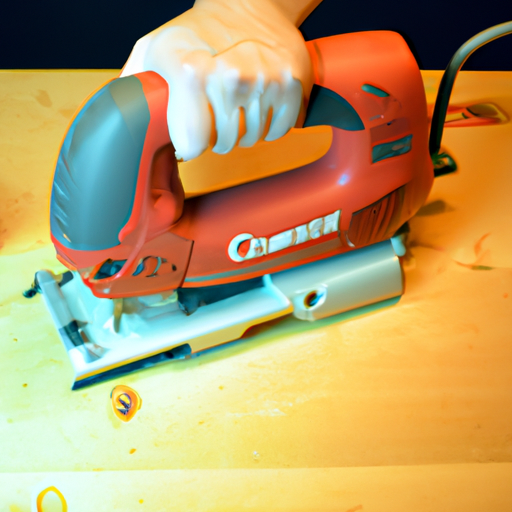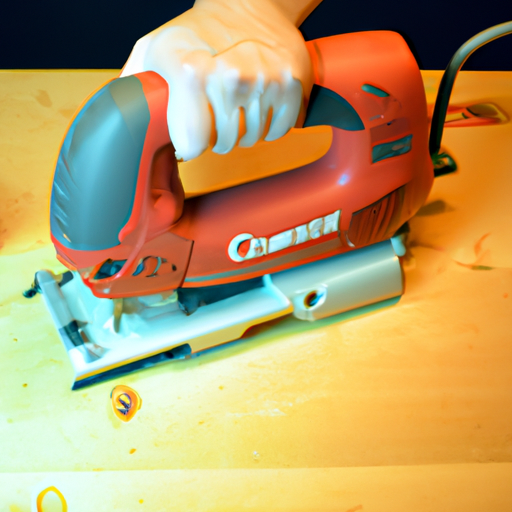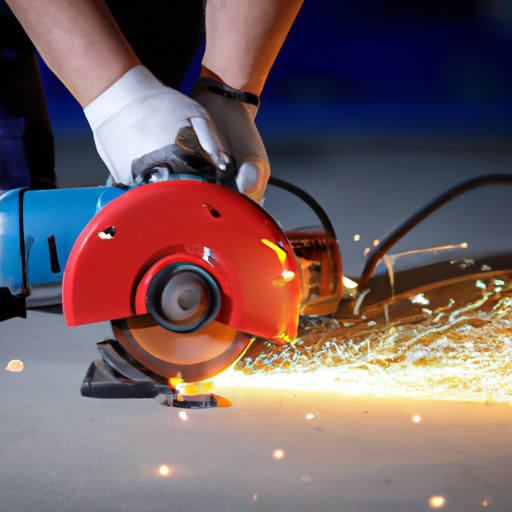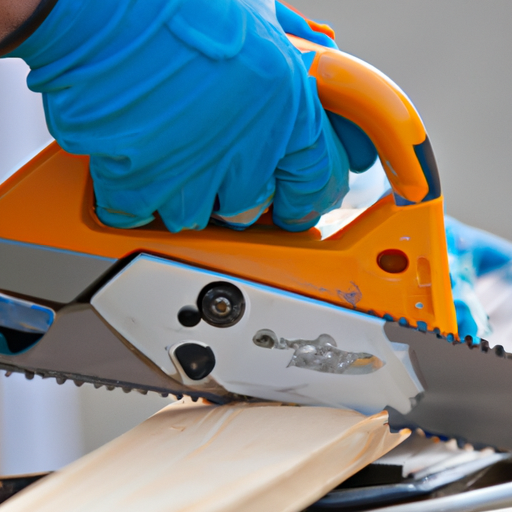Have you ever wondered how to safely operate a battery-powered jigsaw? Well, you’ve come to the right place! In this article, we’re going to walk you through the important steps to ensure your safety and make the most out of your battery-powered jigsaw. So, whether you’re a beginner or an experienced user, stay tuned to learn about the dos and don’ts of using this versatile power tool.
First of all, it is crucial to familiarize yourself with the jigsaw and its components. Take a moment to read the user manual and understand how the various parts work together. This will help you handle the tool correctly and avoid any unnecessary accidents. Additionally, make sure your battery is fully charged before beginning any project, as a low battery can result in a loss of power and make the tool less effective.
Next, it’s important to wear the right protective gear when operating a battery-powered jigsaw. Safety goggles, ear protection, and gloves are essential to prevent any potential injuries. These accessories will shield your eyes from flying debris, reduce the noise levels, and protect your hands from sharp edges or vibrations.
Lastly, always keep in mind the proper cutting techniques. Start by marking the cut line on your material and securing it firmly in place. Then, ensure the jigsaw blade is appropriate for the task at hand and securely fastened. Remember to always cut with a slow and steady motion, allowing the tool to do the work. Trying to force the jigsaw can lead to accidents and damage the tool or material.
In this article, we’ll delve deeper into each of these aspects of safely operating a battery-powered jigsaw. Whether you’re a DIY enthusiast or a professional carpenter, knowing how to use this tool safely is crucial for a successful project. So, let’s get started and make sure you have all the knowledge and confidence to handle your battery-powered jigsaw with ease!
Understanding Battery-Powered Jigsaws
Battery-powered jigsaws are a versatile and convenient tool for anyone who works with wood or other materials that require precise, intricate cuts. Unlike their corded counterparts, battery-powered jigsaws offer the freedom to move around without the hassle of cords and power outlets. In this article, we will guide you on how to safely operate a battery-powered jigsaw, highlighting the benefits and key considerations when choosing the right tool. So let’s dive in!
What is a battery-powered jigsaw?
A battery-powered jigsaw, also known as a cordless jigsaw, is a handheld power tool that utilizes a reciprocating blade to make cuts in various materials, such as wood, plastic, and metal. The jigsaw’s blade moves in an up-and-down motion, allowing for precise and intricate cutting. The battery-powered design eliminates the need to be tethered to a power source, providing freedom of movement and convenience.
Benefits of using a battery-powered jigsaw
Using a battery-powered jigsaw offers numerous benefits for both professional craftsmen and hobbyists. Here are a few reasons why you should consider adding this versatile tool to your collection:
-
Portability: The cordless design allows you to work anywhere without the limitations of power cords. This makes battery-powered jigsaws perfect for outdoor projects or when working in tight spaces.
-
Convenience: With a battery-powered jigsaw, you don’t have to worry about finding an electrical outlet or untangling cords. Simply charge the battery, and you’re ready to go.
-
Versatility: Battery-powered jigsaws are suitable for a wide range of cutting tasks. Whether you need to make straight cuts, curves, or bevels, this tool can handle it all.
-
Ease of use: These jigsaws are designed to be user-friendly, making them accessible even to beginners. The lightweight and ergonomic design ensure comfortable handling for extended periods.
-
Safety: Battery-powered jigsaws eliminate the risk of accidentally cutting through a power cord, reducing the chance of electrical hazards.
Now that we understand the benefits of using a battery-powered jigsaw, let’s move on to choosing the right one.
Choosing the Right Battery-Powered Jigsaw
When selecting a battery-powered jigsaw, there are several factors to consider to ensure you get the best tool for your needs. Here are some key elements to evaluate:
Consider the power and speed options
Battery-powered jigsaws come in various power ratings, typically measured in volts. Higher voltage generally translates to more cutting power, allowing you to tackle thicker or harder materials. However, keep in mind that higher power often results in a heavier tool, which may affect maneuverability.
Additionally, consider the speed options of the jigsaw. Variable speed settings provide more control during intricate cuts and allow you to adjust the cutting speed to match the material you are working with.
Evaluate the battery life and charging time
Battery life is an essential factor, especially if you have longer or more extensive projects. Look for jigsaws with batteries that offer sufficient runtime to prevent interruption during your work. Lithium-ion batteries tend to offer longer life compared to other battery types.
Also, consider the charging time. Ideally, you want a jigsaw that charges quickly to minimize downtime. Some models come with fast-charging capabilities, allowing you to recharge the battery in a shorter amount of time.
Look for ergonomic features
Ergonomics play a vital role in ensuring comfort and reducing fatigue during prolonged use of the jigsaw. Look for features such as rubberized handles, adjustable grips, and lightweight designs. These elements contribute to better control, decreased strain on your hands, and overall improved user experience.
Prioritize trying out different models to find a jigsaw that feels comfortable and well-balanced in your hand.
Now that we’ve covered the necessary considerations when selecting a battery-powered jigsaw, let’s move on to preparing for safe operation.

Preparing for Safe Operation
Before operating a battery-powered jigsaw, it is crucial to take the necessary precautions and familiarize yourself with the tool. Here are some steps to follow for a safe and effective operation:
Read the user manual thoroughly
The user manual provides essential information about the jigsaw’s capabilities, maintenance requirements, and safety guidelines. Take the time to read and understand the manual thoroughly before using the tool. Pay particular attention to the safety instructions, as they will help you avoid potential accidents or injuries.
Inspect the jigsaw and ensure it’s in working condition
Before using the jigsaw, visually inspect the tool for any visible damage or defects. Ensure that all guards, handles, and other components are intact and functioning correctly. Check the blade for any signs of wear or damage and replace it if necessary.
Charge the battery fully before use
To ensure uninterrupted operation, it is important to charge the battery fully before using the jigsaw. Follow the manufacturer’s instructions regarding the charging procedure and recommended charging time. Avoid overcharging the battery, as this can shorten its lifespan.
By following these preparation steps, you will be ready to operate the jigsaw safely. However, personal protective equipment (PPE) is also crucial to ensure your safety during operation.
Using Personal Protective Equipment (PPE)
When using a battery-powered jigsaw, it is important to wear the appropriate personal protective equipment (PPE) to protect yourself from potential hazards. Here are some essential PPE items to consider:
Wear safety glasses
Safety glasses or goggles are crucial for protecting your eyes from flying debris. Ensure the safety glasses fit securely and provide proper coverage over your eyes.
Use hearing protection
Jigsaws can generate a significant amount of noise, which can be harmful to your hearing. Use earplugs or earmuffs to protect your hearing when operating the tool for extended periods.
Wear gloves
Gloves serve multiple purposes when using a jigsaw. They provide a better grip on the tool, reducing the risk of slippage, and also protect your hands from potential cuts or injuries.
Wearing the appropriate PPE is essential to minimize the risk of accidents or injuries. However, it is equally important to set up a safe work area to further ensure your safety.

Setting Up a Safe Work Area
Creating a safe work area is crucial in preventing accidents and ensuring a successful jigsaw operation. Here are some steps to follow when setting up your work area:
Clear the workspace of any obstacles
Remove any objects or debris from your workspace that could interfere with your movements or cause a tripping hazard. This includes cords, tools, and other materials that are not directly related to the task at hand.
Secure the workpiece properly
Ensure the workpiece is securely clamped or held in place to prevent movement during cutting. A stable workpiece reduces the risk of the jigsaw blade deviating or binding, improving accuracy and overall safety.
Ensure proper lighting and ventilation
Adequate lighting is essential for visibility, enabling you to see the cutting line and potential hazards clearly. Additionally, good ventilation helps to reduce the buildup of dust and fumes, resulting in a safer and more comfortable work environment.
By setting up a safe work area, you minimize the risk of accidents and create a conducive environment for efficient jigsaw operation. Now, let’s delve into understanding cutting techniques to ensure precise and accurate cuts.
Understanding Cutting Techniques
Mastering the different cutting techniques is essential for achieving clean and accurate cuts with a jigsaw. Here are some tips to help you become proficient in using the tool:
Choose the appropriate blade
The type of material you are cutting determines the blade you should use. Blades with a higher TPI (teeth per inch) are ideal for cutting materials like wood, while blades with a lower TPI are better suited for cutting metal. Make sure the blade is installed securely and tightened properly.
Master the cutting techniques (straight cuts, curves, bevels)
To make straight cuts, use a straight edge or guide to follow the desired cutting line. For curves, use slower cutting speeds and gradually guide the jigsaw along the curve, maintaining control at all times. Bevel cuts are achieved by tilting the baseplate of the jigsaw to the desired angle.
Practice these techniques on scrap material before tackling your actual project to gain confidence and improve your cutting skills.
Avoid binding and kickbacks
Binding occurs when the blade gets stuck in the material, causing the jigsaw to jerk or jump unexpectedly. To prevent binding, guide the jigsaw at a steady and consistent pace, applying gentle downward pressure. Kickbacks can also occur if the jigsaw blade gets pinched or caught in the material. Maintain a firm grip on the tool and be aware of potential kickback situations.
By mastering these cutting techniques and understanding the potential risks, you will be well-equipped to operate the jigsaw safely. Let’s move on to the next section, where we will explore the proper way to handle and operate the battery-powered jigsaw.

Operating the Battery-Powered Jigsaw
Operating a battery-powered jigsaw requires proper handling and technique to ensure accurate cuts and personal safety. Here are some important points to consider:
Hold the jigsaw correctly
Hold the jigsaw with both hands, placing one hand on the handle and the other on the front guide knob. This grip ensures better control and maneuverability. Maintain a comfortable and secure grip throughout the cutting process.
Start and stop the jigsaw smoothly
To start the jigsaw, apply gentle pressure to the material, allowing the blade to reach its maximum speed before fully engaging. When stopping, release the pressure gradually, allowing the blade to come to a complete stop. Abruptly stopping or releasing pressure can cause the blade to kick back unexpectedly.
Maintain a steady cutting pace
Maintain a steady and consistent cutting speed, allowing the blade to do the work without forcing or pushing too hard. Applying excessive pressure can result in less accurate cuts and increase the risk of binding or kickback.
By following these operating guidelines, you will ensure smooth and precise cutting with your battery-powered jigsaw. However, it is important to be aware of potential hazards and know how to deal with them.
Dealing with Potential Hazards
While operating a battery-powered jigsaw, it is crucial to be aware of potential hazards and take appropriate precautions. Here are some key points to keep in mind:
Avoid contact with the blade
Never place your fingers or any body part in close proximity to the blade while the jigsaw is running. Even when the jigsaw is switched off, exercise caution when handling the blade, as it can still be sharp.
Handle the battery safely
When removing or installing the battery, ensure the jigsaw is switched off to prevent accidental activation. Follow the manufacturer’s instructions for proper battery handling, including storing and charging.
Be cautious of electrical hazards
Although battery-powered jigsaws eliminate the cord-related electrical hazards, it is still essential to be cautious of other potential electrical risks. Avoid using the jigsaw in wet or damp environments and ensure all electrical connections are secure and properly insulated.
By being vigilant and taking precautionary measures, you can minimize the risk of accidents and safely operate your battery-powered jigsaw.
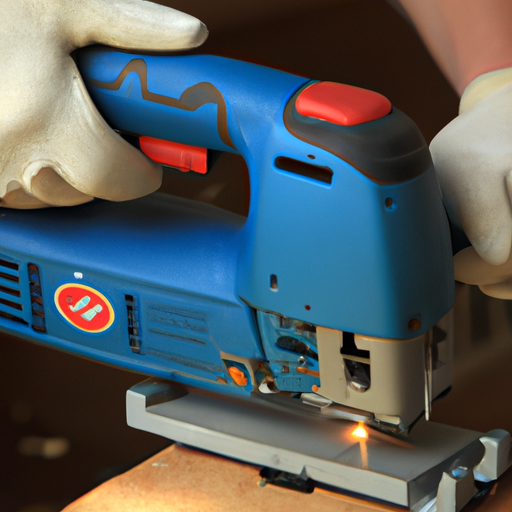
Performing Maintenance and Storage
Proper maintenance and storage of your battery-powered jigsaw are essential to extend its lifespan and ensure consistent performance. Here are some maintenance tips to follow:
Clean the jigsaw after use
After each use, remove any dust, debris, or residue from the jigsaw. Use a soft brush or cloth to clean the tool, paying special attention to the blade and moving parts. Regular cleaning helps to maintain the jigsaw’s performance and prevents the buildup of material that can affect its operation.
Inspect and replace worn-out parts
Regularly inspect the jigsaw for signs of wear or damage. Check the blade, baseplate, handles, and other components for any visible defects or wear. Replace any worn-out or damaged parts to ensure safe and effective operation.
Store the jigsaw and battery properly
When not in use, store the jigsaw and battery in a clean, dry, and secure location. Keep the battery away from extreme temperatures and moisture, as these can adversely affect its performance. Additionally, store the jigsaw in a dedicated case or toolbox to prevent damage and ensure it remains in good working condition.
By following these maintenance and storage practices, you can prolong the lifespan of your battery-powered jigsaw and maintain its optimal performance.
Conclusion
In conclusion, operating a battery-powered jigsaw can be both enjoyable and efficient if done correctly. By understanding the benefits of using this versatile tool, choosing the right jigsaw, and taking the necessary safety precautions, you can confidently and safely complete your woodworking projects.
Remember to always prioritize your safety by wearing the appropriate personal protective equipment (PPE), setting up a safe work area, and following proper cutting techniques. Regular maintenance and storage will ensure the longevity of your battery-powered jigsaw, allowing you to reap its benefits for years to come.
So, whether you’re a professional craftsman or a DIY enthusiast, the battery-powered jigsaw is a valuable addition to your toolkit. Happy cutting and stay safe!
